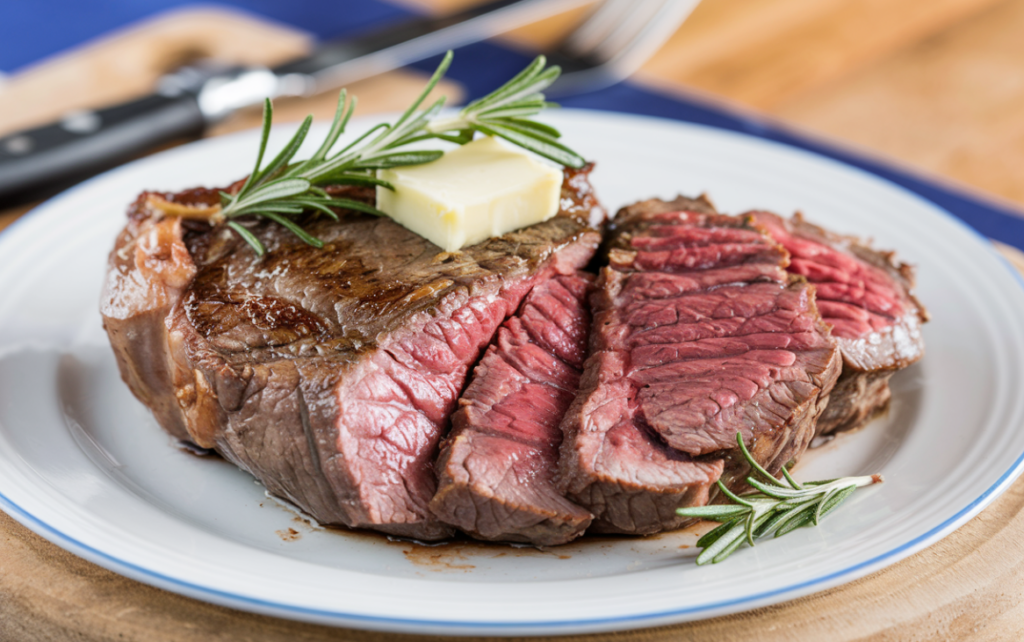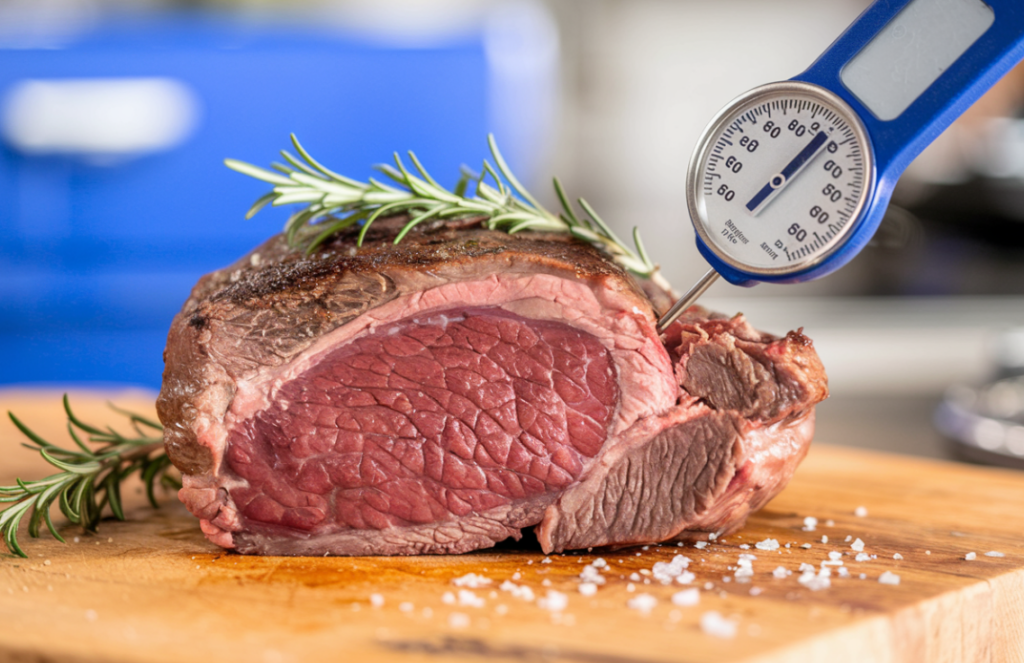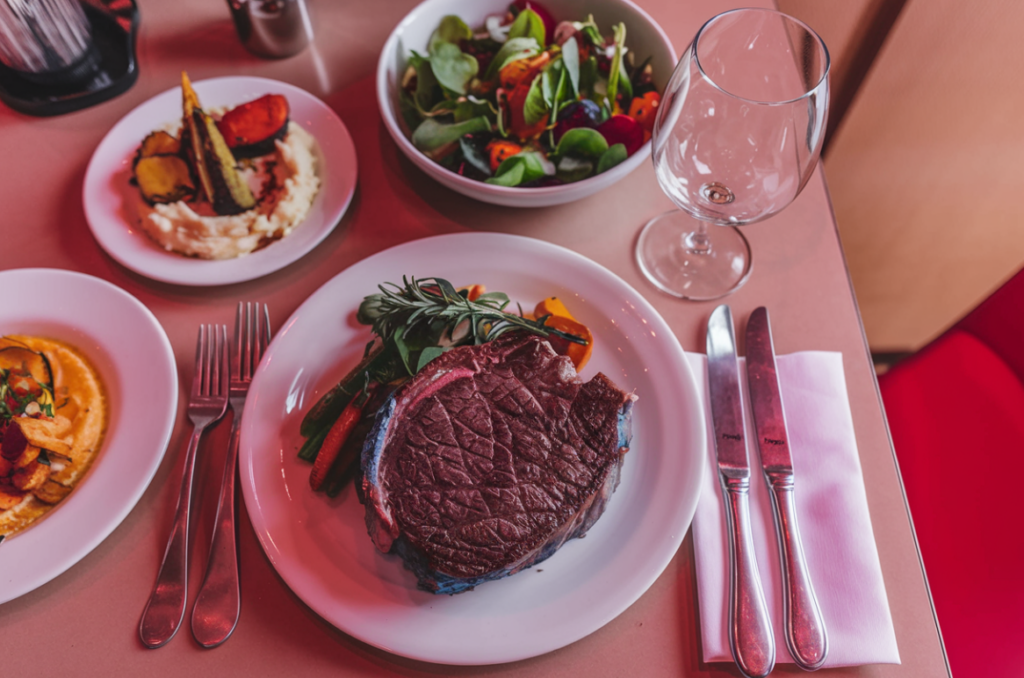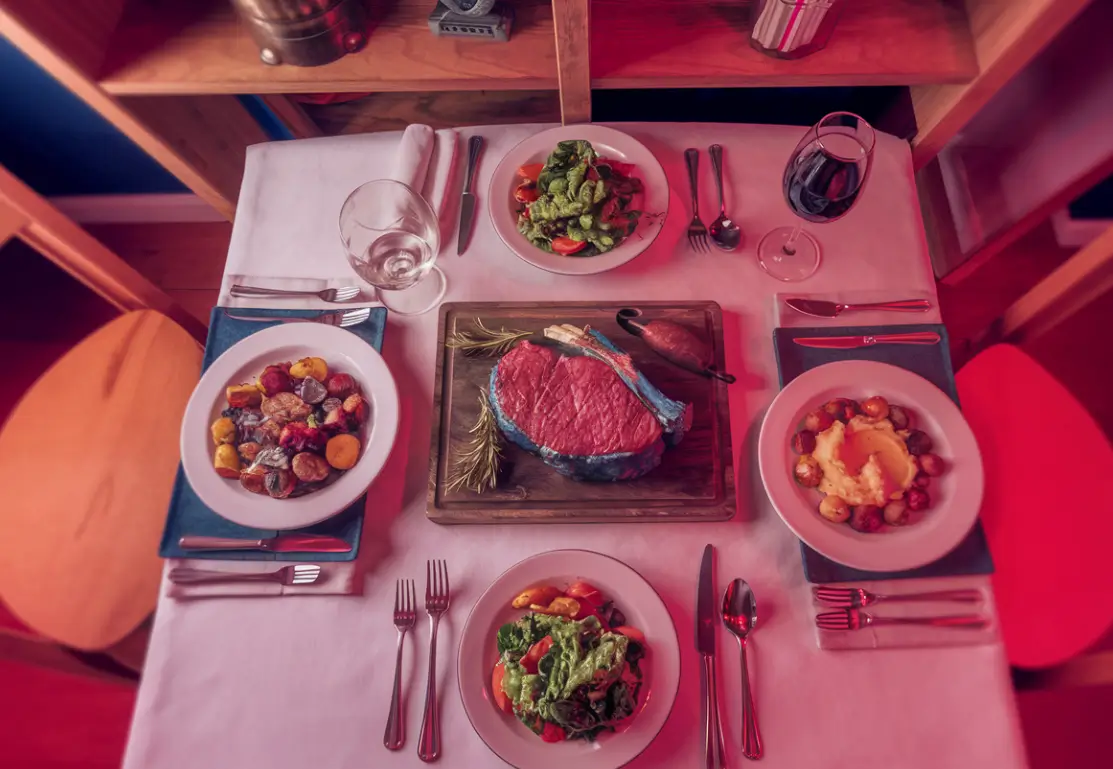Introduction:
Dive into the world of blue steak, a culinary adventure for those who appreciate the rich, intense flavor of minimally cooked beef. This comprehensive guide will take you through everything you need to know, from understanding the science behind a perfect rare steak to mastering the cooking techniques and addressing common concerns. Get ready to impress your guests with a flawlessly executed rare steak that’s both tender and flavorful.

Part 1: Introduction to Blue Steak
What is Blue Steak?
Blue steak refers to beef cooked very quickly at extremely high heat, leaving the center virtually raw with a warm, thin outer layer. It’s characterized by a deep red, almost purple center and a cool, barely warm interior. Unlike other doneness levels, a rare steak retains its natural, almost metallic, beefy taste. Indeed, it offers a unique textural experience, firmer than rarer steaks, yet incredibly tender.
Why Choose Blue Steak?
First off, the intense, pure beef flavor is the main draw for B steak enthusiasts. Furthermore, because of the minimal cooking, the meat retains maximum moisture, resulting in a uniquely juicy experience. In fact, rare steak offers a distinct textural contrast between the lightly seared exterior and the soft, cool interior.
Addressing Common Concerns
Naturally, food safety is a primary concern with blue steak. However, when sourced from reputable butchers and cooked with proper hygiene, the risks are minimized. Consequently, many misconceptions surround rare steak. For instance, some believe it’s entirely raw, but a thin layer is indeed cooked. To illustrate, think of it as quickly searing the surface while keeping the core cool.
Part 2: The Science of Blue Steak
Muscle Fiber and Protein Denaturation
Okay, so let’s get a little scientific. Steak, like all meat, is composed of muscle fibers and proteins. When heat is applied, these proteins begin to denature, meaning they change shape. Now, with rare steak, this denaturation is minimal, preserving the soft, almost jelly-like texture of the raw beef. This is why blue steak has a distinctly different mouthfeel compared to more cooked steaks.
The Maillard Reaction and Surface Browning
But here’s the kicker: even though the inside remains essentially raw, the quick sear on a blue steak is crucial. Why? Because of the Maillard reaction! This magical chemical process is what gives seared foods their rich, brown crust and complex flavors. For a blue steak, the Maillard reaction occurs rapidly at high heat, creating a flavorful exterior without overcooking the center.
Internal Temperature and Doneness Levels
Of course, temperature plays a vital role in achieving the perfect blue steak. Specifically, the target internal temperature for a B steak is typically between 115-125°F (46-52°C). This low temperature ensures the center remains cool and essentially raw while allowing for a beautifully seared crust. Now, using a reliable meat thermometer is essential for achieving this precise doneness. Moreover, understanding these scientific principles helps create a consistently perfect blue steak every time.

Part 3: Choosing the Right Cut for Blue Steak
Tenderloin (Filet Mignon)
Alright, now let’s talk beef cuts. The tenderloin, often called filet mignon, is a popular choice for blue steak. Why? Well, it’s known for its buttery texture and delicate flavor, which shines through even with minimal cooking. Plus, its tenderness makes it easy to cut and enjoy, even when cooked rare.
Ribeye
Next up is the ribeye. This cut, with its rich marbling and bold flavor, also takes well to being cooked blue. Now, the marbling (those beautiful streaks of fat) keeps the steak moist and adds a ton of flavor. However, a blue rare ribeye offers a truly decadent experience for steak lovers.
Sirloin
Sirloin, a leaner cut, can also be cooked blue, but it requires extra care. Because it has less fat, it’s more prone to drying out. So, to clarify, a quick sear is key to keeping a blue sirloin juicy.
Other Suitable Cuts
Beyond these, other cuts like New York strip and flat iron can work for rare steak, each offering its unique flavor profile. For example, the New York strip, with its firm texture and robust flavor, is a great option for those who prefer a chewier blue steak. Similarly, the flat iron steak, known for its tenderness and rich flavor, provides a delicious alternative.
Cuts to Avoid
However, leaner cuts like flank steak are generally not recommended for blue steak. These cuts tend to become tough and dry when cooked to such a rare level. Therefore, it’s best to stick with more tender and well-marbled cuts for optimal blue steak enjoyment.
Part 4: Preparing Blue Steak
Method 1: Pan-Searing
Pan-searing is a classic method for cooking blue steak. First, pat the steak dry with paper towels. This removes excess moisture and promotes better searing. Next, heat a cast-iron skillet or heavy-bottomed pan over high heat until it’s screaming hot. Then, add a high-heat oil like avocado or grapeseed oil to the pan. Carefully place the steak in the hot pan and sear for 1-2 minutes per side, depending on the thickness. Remember, the goal is to create a flavorful crust without cooking the center.
Method 2: Grilling
Grilling is another fantastic way to achieve a perfect blue steak. Start by preheating your grill to high heat. Similar to pan-searing, pat the steak dry to encourage a good sear. Place the steak on the hot grill grates and grill for 1-2 minutes per side. Now, grilling imparts a smoky flavor that enhances the natural taste of the beef.
Method 3: Sous Vide
For ultimate precision, sous vide is the way to go. This method involves cooking the steak in a temperature-controlled water bath, ensuring a perfectly even internal temperature. First, seal the steak in a vacuum bag with any desired seasonings. Then, submerge the bag in a water bath set to 115-125°F (46-52°C) for 1-2 hours. Afterward, remove the steak from the bag and sear it quickly in a hot pan or on a grill to develop a crust.
The Importance of a Meat Thermometer
Regardless of the cooking method, a meat thermometer is your best friend when making blue steak. It takes the guesswork out of determining doneness and ensures food safety. Insert the thermometer into the thickest part of the steak to get an accurate reading. Remember, the target temperature for blue steak is 115-125°F (46-52°C).
Resting the Steak
Finally, after cooking, let the steak rest for 5-10 minutes before slicing. Resting allows the juices to redistribute throughout the steak, resulting in a more tender and flavorful final product. So, be patient, it’s worth the wait!

Part 5: Serving and Enjoying Blue Steak
Serving and Pairing Blue Steak
Recommended Side Dishes
So, you’ve cooked your perfect rare steak—now what? Well, let’s talk about sides. Roasted vegetables, like asparagus or Brussels sprouts, provide a delicious counterpoint to the richness of the beef. Additionally, a classic side of mashed potatoes offers a comforting and creamy complement. A fresh, vibrant salad can also balance the intensity of the B steak.
Sauce Recommendations
While blue steak shines on its own, a simple sauce can enhance its flavor. Chimichurri, a vibrant Argentinian sauce made with herbs, garlic, and olive oil, pairs beautifully with the richness of the beef. Alternatively, a classic garlic butter sauce adds a touch of decadence. Keep in mind that the steak’s natural flavor should be the star, so choose sauces that complement rather than overpower.
Seasoning Suggestions
Before cooking, season your blue steak simply with salt and freshly cracked black pepper. This allows the pure beef flavor to shine through. However, if you’re feeling adventurous, try adding a sprinkle of smoked paprika or garlic powder for an extra layer of flavor.
Part 6: Blue Steak vs. Other Doneness Levels
Comparing Blue Steak to Rare, Medium-Rare, and Beyond
Visual Guide to Steak Doneness
Understanding the visual cues of steak doneness is key. A blue steak will have a deep red, almost purple center, with a very thin seared crust. In contrast, a rare steak will have a bright red center, while a medium-rare steak will be pink in the middle. As the steak cooks further, the center becomes progressively browner, reaching a uniform brown color at well done. A good visual guide can be incredibly helpful when learning to judge doneness.
Temperature Chart for Steak Doneness
Internal temperature is the most accurate way to determine steak doneness. rare steak sits at the lowest end of the spectrum, with an internal temperature of 115-125°F (46-52°C). Rare steak follows at 125-130°F (52-54°C), then medium-rare at 130-140°F (54-60°C). The temperature continues to rise with each level of doneness, ultimately reaching 160°F (71°C) and above for well-done.
Flavor and Texture Differences Each level of doneness offers a unique flavor and texture experience. Blue steak retains the most intense, pure beef flavor and a soft, almost jelly-like texture in the center. As the steak cooks further, the flavor mellows, and the texture becomes firmer. Ultimately, personal preference dictates the ideal level of doneness, but understanding the differences helps you choose what you’ll enjoy most.
Part 7: Common Mistakes to Avoid
Avoid These Common Blue Steak Pitfalls
Overcooking
Perhaps the most common mistake when making blue steak is overcooking. Even a few extra seconds in the pan can turn a B steak into rare. Therefore, vigilance and a reliable meat thermometer are essential.
Not Using a Meat Thermometer
Relying solely on visual cues can be misleading, especially with blue steak. Using a meat thermometer guarantees accurate doneness and helps avoid overcooking. Thus, a meat thermometer is a non-negotiable tool for B rare steak success.
Improper Searing Techniques
A poor sear can result in a bland, grayish steak instead of a beautifully caramelized crust. Ensure your pan or grill is screaming hot before adding the steak. Additionally, avoid overcrowding the pan, as this can lower the temperature and impede proper searing.
Not Letting the Steak Rest
Resting allows the juices to redistribute throughout the steak, resulting in a more tender and flavorful final product. Skipping this crucial step can lead to a dry, less enjoyable nearly raw steak. So, patience is key. Let your steak rest!
Part 8: FAQs about Blue Steak
Frequently Asked Questions
Is Blue Steak Safe to Eat?
Absolutely, blue steak can be safe to eat when sourced from reputable butchers and prepared with proper hygiene. The high heat sear kills surface bacteria. However, individuals with compromised immune systems might consider cooking their steak to a higher internal temperature.
How Can I Tell if My Steak is Blue?
A blue steak has a deep red, almost purple center that is cool to the touch. The outer layer will have a thin, seared crust. A meat thermometer, registering 115-125°F (46-52°C), confirms the blue doneness.
What if My rare steak is Too Cold in the Middle?
If your nearly raw steak feels too cold, you can quickly sear it again for a few seconds per side. Alternatively, you can let it rest in a warm place for a few minutes to allow the residual heat to gently warm the center.
Can I Order Blue Steak at Any Restaurant?
Most steakhouses will accommodate a request for rare steak. However, some restaurants might be hesitant due to liability concerns. Communicate your preference clearly to your server, and if they express concerns, consider ordering a rare steak instead.
What is the difference between rare steak and Pittsburgh rare?
While both are very rare, Pittsburgh rare involves searing the steak at an extremely high heat for a longer time, creating a thick, charred crust while maintaining a cool, raw center. Blue steak, on the other hand, has a thinner sear and a slightly warmer center.
Part 9: Conclusion
Embrace the Blue: A Culinary Adventure Blue steak, with its intense beef flavor and unique texture, is a culinary experience for the adventurous palate. By understanding the science, choosing the right cut, and mastering the cooking techniques, you can confidently create a perfect rare steak every time. So, embrace the blue and elevate your steak game to a whole new level!
